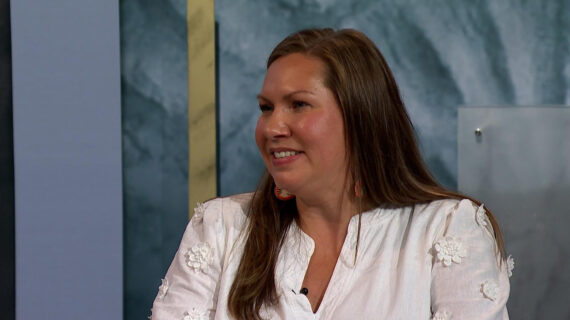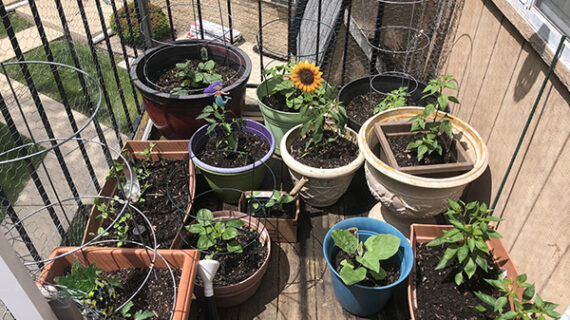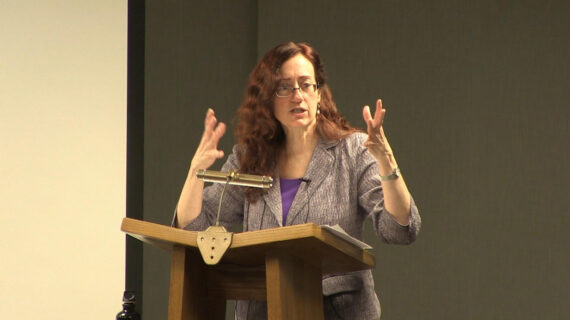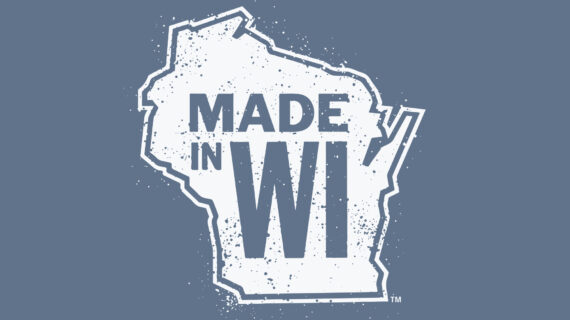– Hello and welcome, I’m Donna Stine.
I’m one of the Wisconsin apiary inspectors.
I’d like to take a moment to introduce myself.
It is customary in the bee world to share how you got into bees.
I started out as a hobbyist beekeeper about 20 years ago.
I had grown up hearing stories from my mom
about the bees my grandfather had when she was a girl
growing up on a sheep farm in Richland Center.
They had to keep the hives on the porch
during the Great Depression to keep them safe
from desperate neighbors.
How they could trade their sugar rations
for other things like shoes during World War II
because they had their honey.
My mom was one of 14 kids, so shoes were a big deal.
After a lot of research, I started with one beehive
in a friend’s field.
I placed those bees in an old, dried-up orchard
of about a dozen apple trees.
Those bees brought those trees back to life
and they’re still producing now, years later.
I worked for the postal service for 20 years,
and finding time to work my bees was always an issue.
It took me years to successfully overwinter my bees.
I understand how important it is to keep trying,
even though it is very discouraging
when you lose your bees every year.
I eventually moved my beekeeping into our yard.
Bees, chickens, big garden, the whole deal.
I was only ever a hobbyist beekeeper,
and the most I ever had at one time was two colonies.
In 2017, we semi-retired, sold everything,
including my bee equipment, and moved to Florida
for a couple of years.
While we were there, I noticed the state of Florida
had bee inspectors on their state job site.
I’m like, “How do you get that job?”
Beekeeping is hot work, and I didn’t wanna mess
with the Florida heat.
I was a letter carrier my last five years
at the postal service, so I understood fully
how hot working outside can get.
We moved back to Wisconsin in 2019 to help family
and my daughter wanted to finish high school here.
Last spring, I saw that Wisconsin
was hiring apiary inspectors.
I only had one entomology course,
but I do have a bachelor’s degree in anthropology
from UW-Madison.
I was hesitant to apply
without any other coursework in bee sciences, but at least
I was an experienced beekeeper.
I applied anyway.
I started this new job in May.
I spent the summer traveling all over Wisconsin,
meeting bees and beekeepers.
With my anthropology background, I like to say
I find the beekeepers as interesting as the bees.
There are different types of beekeepers,
and they each have different relationships with their bees.
Commercial, sideliner, hobbyists, and novices.
I try to understand what each person
is trying to get from their bees
so I can understand where I can be of benefit.
Pollination, selling honey, selling bees,
citizen scientists, or pampered pets.
How can I be an asset to each beekeeper?
We all need to work together to promote bee health.
My job is bee health, but all insects
are in trouble and need our help.
Habitat matters for everything, big and small.
Healthy food, a safe place to live, and clean water.
I’m grateful to have a job where I can make a difference.
The apiary program is one of the oldest programs
in the ag department, dating back to the 1890s.
Our program is housed in the Plant Industry Bureau
in the Division of Agriculture Resource Management.
In some states, honey bees are considered livestock,
so the apiary program is in their animal health division.
But in Wisconsin, invertebrates are excluded
from the definition of livestock,
so the program is in the Plant Industry Bureau.
This is broadly what the apiary program focuses on
over the year.
Each new year, our state apiarist, Frances Hegarty,
mails out honey bee import reports to package producers
and other folks that are bringing in
or causing to be brought in bees into the state of Wisconsin.
And this is based on the statutory requirement
that says anyone causing bees or comb or bee equipment
to be brought into Wisconsin
needs to first report the shipment to us
in writing, along with a certificate of inspection.
We have two seasonal inspectors who start up in mid-April,
first looking at the incoming packages,
and then moving on to primarily hobbyists inspections
through August.
In the fall, we focus on pollination services
and migratory beekeepers.
Almost all of our inspections we do are voluntary
and requested by the beekeeper.
I am the eastern apiary inspector.
My summer inspection territory
is highlighted in blue on this map.
I am the sole inspector November through April.
I also have a secondary appointment for outreach
and education over the winter months.
This smiling gentleman is Patrick Sizemore,
our western apiary inspector.
Patrick’s appointment runs May through October.
The DATCP Apiary Program offers free voluntary inspections
to all Wisconsin beekeepers.
Inspections are scheduled
on a first come, first served basis.
Patrick and I are each responsible for 32 counties.
We interact with beekeepers one-on-one, over the phone,
by mail, at the bee club meetings,
county fairs, and online.
We try to cover the state as best we can,
but we ultimately go where the inspections are requested.
Here’s a map of the 2021 inspections.
In 2020, we inspected 141 beekeepers, opening 2,400 hives.
In 2021, we inspected 287 beekeepers
opening over 2,300 hives.
Since 2011, Wisconsin also participates
in the USDA Bee Survey.
We collect 24 samples of bees and pollen across the state
to help monitor for pests and diseases.
Beginning in 2014, a Pollinator Protection Plan
was developed in collaboration
with the University of Wisconsin Department of Entomology.
A diverse stakeholder group was assembled
to provide content and guide plan development
at three separate stakeholder meetings,
30 stakeholders representing a range of agricultural,
governmental, tribal, and nonprofit organizations
participated in the development of the plan.
Wisconsin’s Pollinator Protection Plan
was released on Earth Day 2016.
Although the comprehensive plan is lengthy,
highlights of the plan were summarized
in a one-page best management practices or BMPs
targeted at specific user groups: beekeepers,
farmers and growers, lawns and gardens,
and prairies, roads, and open spaces.
Scientifically grounded,
Wisconsin-focused, and voluntary,
the overarching goals for the plan
are to improve public understanding
of pollinator health,
identify actions anyone can take to help
and increase communication, expand the quality
and quantity of habitat for managed and wild pollinators,
minimize stressors on managed and wild pollinators,
increase managed honey bee hive health and survival,
and increased outreach on pollinator-friendly practices.
This portion of the presentation contains recommendations
for gardens and lawns outlined
in the Pollinator Protection Plan.
Why help pollinators?
If you help pollinators, they’ll help you.
Pollinators aid seed production
for 87% of the world’s flowering plants,
including 75% of the world’s leading food crops.
This includes the wildflowers and food plants
in your garden, including things like sunflowers, peppers,
tomatoes, fruit trees, herbs, berries, and many more.
Pollinators need the right places to live
and the right foods to eat.
In 2019, the value of pollinated crops in Wisconsin
was $230 million, honey accounting for $6.5 million.
Pollinators increase our nation’s crop values each year
by more than $15 billion.
A pollinator is any animal that visits flowering plants
and transfers pollen from flower to flower.
Most of our animal pollinators in Wisconsin
are insects like bees, flies, butterflies,
wasps, and beetles.
We have one bird that visits flowers,
the ruby-throated hummingbird.
Bees are our most efficient pollinators
because they purposely collect pollen to feed their young.
Most other pollinators are transferring pollen accidentally
as they move from flower to flower.
Here’s a picture of the domestic honey bee
on the bottom left, and a picture
of a bumble bee on the bottom right.
There is a large ball of orange pollen
stuck to the bumble bee’s leg.
When people think of bees, they often think of honey.
But the honey bee is just one of many species of bees.
In fact, Wisconsin is home to roughly 400 species of bees,
including 20 different species of bumble bees.
Domesticated honey bees were introduced from Europe
in the 1600s, while most of the other bees in Wisconsin
are native to North America and perfectly suited
to pollinate the native plants.
Each bee species has unique feeding and nesting traits.
Pictured here top left and bottom right are bumble bees.
Top center, green sweat bee.
Top right is a mason or carpenter bee.
Bottom left, a polyester or cellophane bee.
And the bottom center is a leafcutter bee.
Some of these bees are who will nest
in your manmade bee houses.
One of our pollinators with special concern
is the rusty patched bumble bee.
It was listed as an endangered species in March of 2017.
The rusty patched bumble bee population
has declined by 87% in the last 20 years.
The species is likely to be present
in only 0.1% of its historical range.
Since it was listed, there have been survey efforts
to find populations.
And the most observations of this bee
have been in Wisconsin.
So it is critical that we all do what we can
to help save this pollinator.
Unlike honey bees that live in large colonies,
wild bees nest alone or in very small groups.
Except for bumble bees, most wild bee species are solitary,
meaning that each female bee creates her own nest
to lay eggs in.
70% of wild bees species live in the ground,
while 30% nest in hollow stems or dead wood.
It’s important to note that solitary bees
are docile and rarely sting.
In fact, you likely have solitary bees
in your yard and don’t even realize it.
Most native bees spend the winter in their nest cells
as pupa, emerging as adults the following spring or summer.
So it’s critical to protect nesting areas
from disturbance all year long,
not just during the nesting season.
One exception is bumble bees, which do not overwinter
in their nests.
Some bumble bees are not solitary and live in colonies,
but their colonies do not get as large as a honey bee’s.
Bumble bee workers die at the end of each year.
Only the fertilized queen overwinters
and starts a new colony from scratch in the spring.
Bumble bee colonies can reach a few hundred workers,
while honey bee colonies can reach
into the tens of thousands.
Honeybee survival depends on large stores of honey
to get their colonies through the winter.
Bumble bees only have to make a tiny amount of honey
to sustain their colonies through the breeding season.
Bees rely on pollen and nectar for food.
Pollens vary in nutritional content.
Bees do better where a variety of selection
of flower species are in bloom.
Nectar contains carbohydrates for energy
and fuel for the adult bee.
Pollen contains proteins needed
for the development of young bees.
We like to say nectar is like the sports drink to bees
while pollen is like their pot roast.
[audience chuckling]
Small bees may only travel a few hundred yards
from their nests, while larger bees can go
up to several miles.
Most bees prefer not to have to travel very far
to get a meal or to provision their nest,
so it is important that a good diversity
of flowering plants is available nearby.
Your yard may be a small bee’s whole world.
What are some of the things that you can do
in your landscapes to benefit pollinators?
Probably one of the easiest things you can do
to improve pollinator habitat
is to leave things a little messy.
Wild bees nest in old rodent burrows, cavities,
abandoned bird nests, hollow plant stems,
downed logs, and leaf litter.
Some pollinators need access to undisturbed open ground
for their nest sites.
Another improvement you can make
is to plant bunch grasses like little bluestem.
Bumble bees and solitary bees will nest under the tussocks.
If possible, avoid disturbing existing bee nests.
They may look like anthills,
so watch for who’s occupying the nest before you destroy it.
Even predatory wasps can be beneficial
as long as their nests are not in high traffic areas.
They like to go after the garden pests
that you’ll find chewing on your vegetable plants.
We recommend you use caution with homemade
or store-bought bee houses.
They can harbor pathogens if not properly maintained
and may be colonized by wasps and other insects.
The Xerces Society provides guidelines
for creating homemade bee nests on their website.
Choose plants that are suited to your geographic region,
soil, and climate conditions.
Include flowering plants native to your area.
Native plants tend to attract and support more pollinators
and are usually lower maintenance.
Many pollinators are plant specialists
and will only be found where their preferred host plants
are present.
The Xerces Society and the Pollinator Partnership
have regional planting guides for flowers
that bloom throughout the spring, summer, and fall.
Many native insects only reproduce
on their one special native plant.
Avoid flower varieties that are double-flowered
or otherwise highly modified by breeding.
These flowers often have little pollen or nectar
and are difficult for bees to navigate.
Pollen production and nectar are often bred out
of these flowers, leaving them useless to most pollinators.
Many gardeners wanna see butterflies in their yard.
So it’s important to remember
that most butterflies require special plants.
For example, monarch butterflies on the left
and the endangered Karner blue butterfly on the right.
Adults of both of these species will nectar feed
on many types of flowers, but as caterpillars,
they are both very picky.
Monarch caterpillars only feed on milkweed plants,
and Karner blue caterpillars only feed on lupines.
Aim to have at least three flowering plant species blooming
in each season, spring to late fall.
Not just flowers; try to select a variety
of blossoming herbs, fruits, vegetables, trees, and shrubs.
Choose a variety of flower colors.
Bees are most attracted to blue, white, yellow,
and purple flowers.
Butterflies are drawn to orange, red, yellow, and purple.
Flower flies prefer white and yellow.
And hummingbirds are particularly attracted to red.
And let your herb garden bloom.
Pollinators love flowering mint, lavender, basil, oregano,
garlic, chives, and parsley.
And don’t be afraid to let dandelions, clover,
and other flowering plants like creeping Charlie
bloom in your lawn.
These plants provide an important food source
when most other plants aren’t flowering yet.
And the bees will thank you.
Before applying chemicals to your lawn,
mow to remove clover or dandelion blooms
that might attract pollinators.
This will help limit direct contact.
By the time the clover or dandelions grow back,
there should be fewer chemicals present
in the pollen and nectar.
Before applying any pesticide, whether they’re insecticides,
fungicides, or herbicides, assess the damage
and identify pests.
The University of Wisconsin Plant Disease Diagnostic Clinic
has resources to help you identify pests
and determine if action is warranted.
Pay attention to pesticide labels
that say highly toxic to bees,
toxic to bees, or extended residual toxicity.
Choose products and mixes that are less toxic
to pollinators using available online tools.
The University of California
Integrated Pest Management website
has an online tool to look up pesticides by name.
It will return the information on the pesticide
and give you a score for how toxic it is to pollinators.
Pesticide applicators could then choose products and mixes
that are less toxic to pollinators.
If you’re using a pesticide in your yard or garden,
remember that the label is the law,
so follow directions exactly.
Immediately report suspected pesticide-related bee incidences
to Wisconsin DATCP Pesticide Program at 608-224-4529.
Do not apply insecticides to plants when they’re flowering
or to areas where pollinators may be nesting.
If a pesticide advertises that it protects for 12 months,
it is likely systemic and should not be used
on some blooming plants that are highly attractive
to pollinators.
Pesticides that are systemic migrate
throughout the whole plant and can persist
in the plant soil for weeks or months.
The more neighbors protecting pollinators,
the bigger the impact.
Education goes a long way.
A conversation or a well-placed sign
can change someone’s mind.
Is this landscape neglected or planned?
There are many opportunities to participate.
The links on this slide will take you
to some helpful resources.
Participate in the Million Pollinator Garden Challenge.
Advertise your pollinator-friendly lawn.
Learn to identify honey bee pests,
wild bees, flies, and wasps.
And prepare and participate in citizen science projects.
The other topic I wanted to cover today is beekeeping.
Beekeeping is a rewarding venture,
but new beekeepers may easily become overwhelmed
by all the considerations that go into keeping bees.
Habitat loss, nutritional deficiencies,
pesticide exposure,
parasites, pathogens, and harsh weather
are some of the main causes of concern for bee health.
Parasites, improper nutrition, and pesticide exposure
are all compounding issues that can make colonies
more susceptible to pathogens and decline.
The following practices are recommended
to improve overall pollinator health
and to minimize hive loss in managed bees.
Most of these practices apply only
to the most common managed bee, the European honey bee,
but some also apply to bumble bees kept
for greenhouse pollination.
Apiary location plays a big role
in overall hive health and performance.
If possible, select a south-facing site
that receives plenty of sunlight with a northern wind break.
Try to avoid low areas with little airflow
and stagnant puddles.
Space hives out as much as possible,
preferably next to natural landmarks like shrubs,
trees, roads, and field edges.
If your hives are in town, be sure to check
with your local municipality for any beekeeping ordinances.
And be neighborly.
If you are considering keeping hives near property lines,
communicate your intentions with neighbors
and be sensitive to their concerns about stings.
Open communication and education is the best way
to get nearby farmers and homeowners
to help protect your bees.
Honey bees need a diverse diet.
The best way to ensure adequate nutrition
is to place beehives in areas where at least three species
of flowering plants are in bloom at all times
from early spring through late fall.
Bees also forage for water and will visit whatever source
is closest to their colony.
These sources can include ponds, streams,
leaky outdoor faucet taps, bird baths,
dog dishes, or the neighbor’s pool.
During hot weather, honey bees use water to cool the colony
by fanning and evaporating water droplets inside the hive.
It’s a good practice to provide a clean water source
for your bees so they don’t become a nuisance.
And check your hives often to make sure your bees
are bringing in nectar and pollen.
When food is scarce or if they’re still active
in the late fall or very early spring,
provide a pollen or protein substitute in a sugar syrup.
You may want to provide protein patties
and a carbohydrate source
when there are not enough flowers blooming
throughout the year.
In late fall, add sugar or a candy board to any hive
that has less than 100 pounds of honey stored
going into winter.
There are many dos and don’ts when it comes
to successfully overwintering bees in Wisconsin.
Here are some of the things you should do.
Assess hive strength before the winter.
Small, healthy colonies can be combined
and the poor queens replaced.
Insulate the hives, including the top.
Add ventilation near the top of the hive
to reduce condensation.
Condensation is what often kills the bees.
They keep a tight cluster of a certain temperature
and they only heat themselves, they don’t heat the whole hive.
And that creates moisture, and if that rises up,
collects on the top of the hive, and condensates back on them,
that moisture prevents them
from being able to maintain their temperature
and that often, they’ll freeze to death.
We also recommend an entrance reducer or a mouse guard
at hive entrances in the fall.
And keep hives behind a windbreak
or move them inside a shed or a barn for winter.
The University of Minnesota Bee Lab
has an excellent manual titled Beekeeping in Northern Climates,
outlining how to successfully overwinter hives
in our conditions.
Pest and disease management is also critical
for successful beekeeping.
If you aren’t regularly inspecting for
and managing pests and diseases in your hive,
you will lose your bees.
Not only that, your hives, weakened with pests
and pathogens, are susceptible to robbing
by other neighboring stronger hives,
which can themselves then become infected
or infested from your problem hives.
Some of the same pests and pathogens
can also be transmitted to wild bees.
Use a hive inspection sheet
to track regular hive health assessments,
including mite counts, maintenance activities,
treatments, and more.
You can purchase hive inspection sheets
from bee supply stores, find templates online,
or create your own.
Keeping good notes will help you see trends
and remember details that you may find relevant
at a later date.
As you can see in this picture, it was early in the year
because my bee suit
is definitely not that white anymore.
We recommend using Integrated Pest Management or IPM
to manage honey bee pests and diseases.
IPM strategies prioritize preventive solutions
to pest problems and decrease the probability of pesticide
or antibiotic resistance.
It also reduces chemical exposure
and contaminants in the hive.
It’s the responsibility of every beekeeper to be able
to recognize symptoms of disease and how to handle
and sample colonies for mites and other pests.
You can educate yourself by attending bee club meetings,
seminars, and workshops, or subscribing to trade journals.
Every colony in America currently has, has had,
or will have Varroa mites.
These mites are the number one enemy for bees
and are the leading cause of colony death.
Varroa mites evolved in Asia on the smaller Asian honey bee.
They have spread to all populations
of European honey bees except for Australia.
The Asian bees can live with these mites.
The European honey bee is, for the most part,
defenseless against these mites.
Monitoring mite levels at least four times a year
will help you to gauge when you need to step in
and help your bees manage the mites and also
if your previous management techniques were effective.
Pictured here is a mite counting technique
called the powdered sugar roll.
A half a cup of bees is roughly equal to 300 bees.
Nationally, the treatment number is 9 mites in 300 bees
or 3%, but in Wisconsin with our harsh winters,
we recommend trying to keep your mites under 1%
or 3 mites in 300 bees.
The conversation with bee health starts with Varroa mites,
but it doesn’t end there.
Varroa mites directly kill and weaken the bees.
They are also a vector for honey bee viruses.
Viruses that didn’t previously have a way to spread
far and wide are now showing up in more and more places.
Controlling Varroa mite levels will also help
to keep the virus loads down.
The picture on the left is a healthy-looking worker bee
with a Varroa mite on her back.
The bee on the right also has Varroa mites,
but this bee is infected with deformed wing virus.
A bee born in this state will never fly
and only lives a few days.
For videos demonstrating techniques
for combating Varroa mites,
visit the Honey Bee Health Coalition website.
The Honey Bee Health Coalition also has a tool
on their website to help you choose treatment options
for Varroa management.
The tool asks you questions
about your current weather conditions, your bees,
and helps you understand your treatment options.
This helps beekeepers make confident,
well-informed choices while they’re learning,
and so they’re prepared as they progress.
The small hive beetle is a newer pest
for Wisconsin beekeepers.
Small hive beetles were accidentally introduced
into the United States from southern Africa in the 1990s.
Maintaining strong hives with prolific queens
is the best way to prevent small hive beetles
from infesting a hive.
Small hive beetles are strong flyers
and can fly several miles to detect
and infest weaker, smaller colonies.
If beetles are found in a hive,
act quickly using Integrated Pest Management
to control the problem.
Small hive beetles do not reproduce well
in our environment,
so they’re more of a problem in southern states.
When harvesting honey, do not bring honey supers
that have brood and therefore beetles
into the extracting facility.
The beetle larva will defecate in the honey while eating it,
ruining the honey for both the bees and humans.
There are other challenges to bee health.
Know what to look for and how to monitor
for bacterial foulbrood diseases.
The mottled appearance of live intermixed
with dead, discolored brood cells could indicate a number
of ailments, including European or American foulbrood.
The foulbrood diseases were named
for where they were first reported.
European foulbrood has been
in North America since colonial times.
American foulbrood was differentiated
from European foulbrood in the early 20th century.
Foul refers to an unpleasant smell.
American foulbrood is the most damaging brood disease
and is highly contagious among bee colonies.
The foulbrood spores can remain viable
in the woodenware for up to 70 years,
so burning the infected combs and the equipment
is the surest way to prevent its spread.
European foulbrood is treatable with an antibiotic.
Testing kits are available at most bee supply stores.
Pictured on the top is the roping test.
A dead pupa will pull from the comb
an inch-long, thick, gluey, ropey string.
We recommend caution when buying used equipment.
Used beekeeping equipment can be contaminated
and show no visible signs.
There are viral, fungal, and other pathogens
like microsporidians that can affect bees.
Many symptoms of ill health in beehives
have no direct treatments currently
and will usually disappear with good care,
good weather, and a strong honey flow.
A seasoned beekeeper learns to read the hive,
recognize the signs of bee stress,
and has several options in mind.
Beekeeping is a year-round job,
always trying to stay ahead of the problems
instead of reacting after the fact.
And always be on the lookout in your hives
for new, non-native exotic pests.
Top left is the famous Asian giant hornet.
Top right is a Varroa mite pictured
next to a Tropilaelaps mite, which isn’t here yet.
Bottom left is an African Cape honey bee.
And bottom right is a European honey bee for scale
with a smaller Asian honey bee.
If you suspect any of these or other exotic pests
or diseases in your hives,
please contact the DATCP Apiary Program at 608-224-4629.
Over the summer, we received about three dozen reports
of suspected Asian giant hornets in Wisconsin.
We were able to follow up with all of them.
The majority turned out to be cicada wasp killers.
And the second most frequent reported
ended up being the horntail wasp.
Wisconsin gardeners are the eyes and ears
and boots on the ground.
If you see anything suspicious,
please contact our pest hotline at 866-440-7523.
Always remember, the label is the law.
Miticides are pesticides.
Always read and follow label directions exactly
before applying any treatments to your colony.
Take all precautions and wear proper protective equipment.
Rotate treatments using Integrated Pest Management
to reduce the likelihood of pesticide
and/or antibiotic resistance.
We recommend replacing one third of your old brood comb
with new each year.
This will help to reduce the buildup of pathogens,
pesticides, and antibiotics.
As of January 2017, the Veterinary Feed Directive
is now in effect.
Honey bees are considered livestock.
This means that in order to purchase
and apply medically important antibiotics to a beehive,
a beekeeper will need either a Veterinary Fee Directive order
or a prescription from a licensed veterinarian,
depending on the treatment required.
Beekeepers will need to work with their local vet
to establish a veterinary client-patient relationship
before any orders or prescriptions are issued.
We recommend you also register your bees on BeeCheck,
an online voluntary communication tool
that enables beekeepers and pesticide applicators
to work together to protect apiaries
through use of BeeCheck mapping.
Pesticide applicators should always check FieldWatch
before spraying pesticides.
FieldWatch’s mission is develop and provide easy to use,
reliable, accurate, and secure online mapping tools
intended to enhance communications
that promote awareness,
stewardship activities between crop producers,
beekeepers, and pesticide applicators.
Migratory beekeepers have additional challenges
to keep in mind when transporting bees
for pollination services
or to southern overwintering locations.
Long-distance transportation, poor diets,
and overwork are stressful for bees.
When transporting bees, maintain a consistent temperature,
make sure they have adequate ventilation
and proper hydration.
Feed supplemental carbohydrates and/or protein
before and after crop bloom.
Always review the regulations for any state
that you intend to ship bees into at apiaryinspectors.org.
Each year, packaged bee and nucleus colony suppliers
must submit to DATCP a honey bee import report
along with the certificate of inspection
before their bees can be shipped into Wisconsin.
This law also applies to anyone bringing in bees
for pollination services.
This form can be printed from our DATCP website.
Listed here are additional helpful resources.
The Wisconsin Pollinator Protection Plan.
For a full copy, visit our website, datcp.wi.gov.
Keyword search pollinator protection.
Participate in surveys and keep up
with research at beeinformed.org.
DATCP apiary inspections are available
on the apiary page in the website.
Diagnostic guide from the Penn State Extension.
Free diagnostic services from the USDA Bee Lab.
And register your hives at beecheck.org.
So this summer, Patrick and I are both new,
and we really didn’t know any beekeepers per se.
So I would personally would go from meeting to meeting,
meeting folks and scheduling inspections.
So I kind of worked week-to-week.
And because I was not very good at remembering
exactly what part of Wisconsin I was in,
there were a couple of days
where I drove three or four hours
from one inspection to another because I,
and I really have to remember to check my calendar
and the map before I agree to things,
which was a big problem.
And, but for the most part, Wisconsin bees are healthy.
It’s just that it’s a little overwhelming,
there’s so many things to learn when they first start.
And Varroa mites are just another insect
that can be managed, just like managing bees,
but when you have so many other things
to learn when you’re first starting,
they seem overwhelming and daunting.
And some people think that they can not treat
and it’ll be fine.
In reality, all you’re doing is weakening your bees slowly,
and an untreated hive will eventually die
after about two years, if they make it
through the first winter at all.
And it’s kind of like a dog with heartworm or…
If you’re not treating, those bees are suffering.
These mites bite through their exoskeleton
to feed directly on their insides.
So if you’re not treating,
your bees are not healthy or happy.
And I think if you’re gonna be a steward for an animal,
it’s important to take the best care of them you can.
And some people are really worried
about putting chemicals into the hives,
so they have created organic, acid-based treatments
to treat the mites and things for the folks
who didn’t want a synthetic chemical in their honey.
And there’s been severe testing on these chemicals
to make sure that they’re safe for human consumption.
And there are strict guidelines for the beekeeper
about when they can put them on if there’s honey on the hive
and if there’s not and those kind of things
so that people can have peace of mind about,
so you can still go as organic as possible
without putting your bees at risk.
There are a lot of different research projects right now
going on about bees.
Interest in pollinators has helped considerably.
There was hardly anyone in the bee sciences 20 years ago.
Most of the professors who were there then
were aging out of the system.
And then we had the Colony Collapse Disorder,
which brought a light to the fact.
And people became aware that, how everything’s connected
and we all need to pay attention.
And that has brought a lot of interest
into the bee sciences,
there are a lot of people doing research.
Some people use bees as their tool for science
and they’re doing higher levels of research on diseases
and how the brain works and things, and the bees are a tool.
And some folks, God help those grad students,
they literally sit in front of a beehive all summer
for three hours a day, counting bees as they go in and out.
And bless the grad students,
they’re the backbone of science. [all laughing]
And so I really love my job
because I get to see bees every day.
I missed having bees and, but having bees can be stressful.
And some people really just aren’t cut out
to be beekeepers; the everyday worry about
these little creatures that you’ve taken responsibility for,
and you can’t just sit outside the beehive
and know for sure what’s going on inside.
And God bless those folks, I love it
when they do their research and find out ahead of time
before they spend all that money and time and effort
to learn that maybe beekeeping isn’t for them
and they haven’t killed a couple thousand bees
in the process.
And for everyone else who, you know,
is allergic or terrified of bees, the best thing you can do
is plant flowers in your landscapes,
as many as you can find that you like.
They don’t always have to be native.
Natives are best for the local native,
but any flower that has pollen will help the bees.
And a lot of the bees do feed on crop plants
and ornamentals in your garden.
The idea is, you know, in everything in life, moderation.
So, you know, if you really need or want
that one beautiful plant that, you know, is from Asia,
plant it, but just make sure it’s not invasive
and it’s not gonna spread and damage the environment.
And, but what we need to do in this country
is kind of replace half of our lawns
back to a native wild space so that these animals
and these insects have places to travel
so it is not an isolated island,
but they can travel throughout the landscape and benefit.
And I think we’d all benefit from a more natural landscape.
And…
Anything else, okay, oh, my job.
So what I do when I go out is, you know,
I meet each beekeeper, I try to understand what they need.
If they have a health concern, then, you know,
we deal with that first, and then otherwise,
I especially like, I like to get to the new folks
who are really unsure of their beekeeping.
And then, of course, I seem like a genius ’cause,
you know, I know more than them. [all laughing]
And so we show them what I look for,
what they should be seeing,
where they can improve their bee husbandry,
give them the confidence that they know what they’re doing
and that they can do this.
And then also give them someone that they can call
when they have questions or concerns or if, you know,
there’s someone who sometimes can be that friendly face
who will be at the bee meeting with them.
And the other part of my job is I travel,
try to get to all the bee meetings that I can,
which can be difficult, like I have one next Tuesday
in Door County.
That same night, they also have a meeting in Milwaukee
and it’s like, so I can’t go to both
of those meetings every month;
I have to trade off one to the other.
And some of the bee clubs are spectacular,
big groups full of big speakers
and great lectures and a lot of knowledge.
And some of them are just small, little organizations
that have just getting started.
And, you know, they’re all trying to work together
to help promote education for themselves and each other.
But I think it’s important to join a local bee club
because they have the information
about your local bees,
what your bees in your area are eating,
what kind of conditions that they’re experiencing.
A lot of the bee literature online
and things is from southern states,
and honestly, it’s a whole different world
keeping bees in Florida than it is in Wisconsin.
And even the difference between Walworth County
and Vilas County can be night and day.
So it really helps to have a local bee club
that you can rely on and have a place to go for information.
And sometimes, you can get, say you had an incident
where your queen didn’t make it.
You might be able to find someone at the club
who has a queen for you.
And we talk about people making these shady queen exchanges
in parking lots and gas stations
and in the middle of nowhere. [audience laughing]
But when you order bees through the mail,
you can’t control what conditions
those bees experienced.
And believe me, I worked for the post office, those bees,
and sometimes what happens is the bees get overheated.
And that won’t kill the bee,
but it’ll ruin her ability to be fertile.
So you’ll have what looks like a healthy-looking queen
that you spent a good amount of money for
and she won’t produce for you the way you need to.
And what’s really interesting with me about the beekeepers
is they have such different relationships with the bees.
The people who are just in it for honey
do everything they can to maximize that, to get, you know,
as much bees working as they can
and focus just on the honey part of it.
And some folks just wanna have bees
in their yard to help pollinate,
and I’ve seen some very expensive beehives
that are very beautiful and some very beautiful yards
in the suburbs.
And they really could care less if they get honey;
they just want the bees.
And so they’re interested in making sure those bees
are as healthy as possible and successful.
And some of the commercial folks,
they’ll switch out queens three or four times a year
if they need to.
They’re ruthless when it comes to,
they could care less if a single colony dies.
They focus on the overall picture.
For them, it’s strictly, you know, a job
and they have a whole different relationship with the bee.
And I just find that fascinating that this one animal
can have this many relationships with this many people
and still basically, bee husbandry stays the same.
Your bees, no matter what conditions they live in,
need those basic things from you:
a safe place to live, food, and water.
And to be as healthy as possible.
And what kills a lot of our bees is our winters.
It’s just, it gets so cold.
And then with the winters we’ve had lately
where the temperatures change so quickly in one day,
the bees can’t move about the hive, eat,
and then get back into a cluster quick enough
when the temperatures drop so fast
to survive those cold snaps.
And the other thing is that when it’s been really warm,
like it was last fall, bees that would normally have been
in a cluster and kind of waiting for spring
are up and active for many more months longer
than they would’ve normally.
So they’re going through their food stores rapidly.
And so some of them were starving before Christmas.
And if a beekeeper doesn’t know to check
and to keep ahead of them
and feed them when they need to be fed instead of
on some sort of imaginary calendar
they have in their brain,
your bees can starve before winter even started.
And we had a lot of people who lost bees this fall
for that reason.
And now this time of year, say we get a really warm March
but there’s no flowers blooming yet.
Then those bees are gonna be very active,
but there won’t be any food in the environment.
So a lot of the bees will starve between March and May
because we think, “Oh, it’s warm, they’re safe now,
they’re not gonna die from the cold,”
but then they’ll starve to death, so.
And there’s nothing worse, so when you open your hive
and you realize that they starved to death
and it was you who killed them.
You can’t blame it on the mites,
you can’t blame it on the weather.
It was you who dropped the ball and didn’t stay on top of it.
And that’s one of the reasons I had stopped beekeeping
is because that last time I opened a hive and I realized
that I was the reason they didn’t survive,
I realized that working 60 hours at the post office
wasn’t conducive to being a very good beekeeper, so.
But it’s one of the things, you are so discouraged
when you open your hive and you find your bees dead
and you’re like, “I’m an idiot
and I am never doing this again.”
And then a couple months go by and you start thinking
about it and the weather gets nice,
and then, “Maybe I’ll try it again,
I think I know what I did wrong,”
or “I’ll try this differently,” or.
And it’s kind of an addiction and honestly,
it can be a very expensive hobby.
There are lots of things to buy and lots of little toys
and tools and things that people wanna sell you, but…
And if you’re in it to make a living making honey,
that is a real commitment, and you really need
to do your research and do the math
and plan ahead if that’s your goal.
But as far as, I think it’s a great hobby
in that you always are learning something new.
I know gentlemen who’ve been five, six generation beekeepers
who are in their 70s
who still learn something new every year.
And so it’s a very rewarding hobby.
And, but like I said, it’s not for everybody.
And it’s okay to admit that and support, you know,
your local beekeepers by buying local honey
and planting flowers.
The Apiary Program is kind of an afterthought
in the Plant Department.
We just have the two apiary inspectors.
Florida has, for example, 16 apiary inspectors
because they have bees that are active all year long.
And so those people have a much more–
And then also in Wisconsin, because our inspections
are voluntary, people don’t have to be inspected
unless they want to be.
We’re not showing up at the front gate of the farm
and demanding to see your bees and make sure
that you’re not spreading diseases and things.
So that, I love that part.
I think it would be a different job if I had to come
and, you know, impose myself upon people
who didn’t want me on their property.
I get stung almost every day; it’s, one or two is normal.
I have had a couple days where I miss the zipper
here or there, and it’s amazing how those bees
can find that little bitty space
and next thing you know, you have a face full of bees.
And this summer, I was planning on going on a cruise.
And the day before, I’ve got a hat full of bees.
And I’m thinking, oh God, I’m trying to squish them
in my hair so they don’t sting me
in the face so I can go on the airplane
without looking like I’ve been beaten and battered.
And, but it’s amazing is that it hurts so bad
for just a second.
Sometimes, I get a little swelling, but not much,
but after a day or two, I barely could tell you
I was stung anymore.
And sometimes, it itches more like a mosquito bite
than anything else, and that is what aggravates me more,
is sometimes I’ll get like an itchy spot that won’t stop.
But yeah, that first time I had a mask full of bees
was quite shocking, but now I hopefully will remember
to zip all my zippers and pay attention.
And a lot of folks like to go into their bee yards
with as little equipment as possible.
I have always been of the opinion
that you should go in fully suited up
so you’re ready to deal with whatever needs to be dealt with.
Like if you come across a hive where the queen has died,
sometimes those bees will be more aggressive.
And so what normally were nice, docile bees, the one time
you go out there without equipment, will be all angry.
And bees automatically go for your breath and go for your eyes
because if they’re fighting something like a bear,
those are the two easiest things for them to attack.
So they’re gonna go for your face,
so if you’re wearing only one piece of equipment,
I recommend a veil so that you don’t have bees in your eyes.
But I have always gone in fully suited up, gloves,
the whole shebang, so that I can get in and get out
and not disrupt the bees any more than I have to.
We recommend you try to get into your bees
like once every two weeks in the summer.
It takes 16 days for bee from an egg to go to a queen cell.
And so if you’re not in there every two weeks,
you can sometimes have them starting to swarm and things.
And if the bees are swarming, they’re not making honey,
so they’re making bees.
Swarming is not good for the beekeeper,
but it’s what the bees want to do, it’s how they reproduce.
So, and they will swarm for like two kinds of reasons.
They will swarm because they don’t like where they’re living
or they think they can do better or they need to do better
or, say, their old queen is getting sick or has died
and then they need to replace her.
But also, when the weather’s good,
they swarm as a way of reproducing.
So they really want to swarm, and sometimes people think
that they’ve done something wrong if they’re swarming,
but no, it’s a sign that your bees are healthy
and they wanna spread out and take advantage
of the new spring weather so that they can make more bees.
And so what’s interesting about swarming is,
when the bees are ready to swarm,
they don’t want their queen laying eggs,
so they’ll run her around and stop her from laying eggs
and make her lose weight so that
when it’s time to swarm, she can fly.
And when they swarm, the old queen leaves
with like two-thirds of the bees to go and find a new place,
leaving behind eggs and young bees
to raise their own new queen and start over.
And so sometimes, you’re lucky and you can catch that swarm
before it gets very far, or some people put out traps
and try to attract other people’s swarms.
You know, the best bees are free bees.
[audience chuckling] And we always say,
if you’re planning on trying to catch a swarm,
it’s important to have your equipment ready,
you know, you already have a hive to move them into
and things so you’re not trying to run to Farm & Fleet
in the afternoon to buy a hive for these bees
that you have in your garage or whatever.
And, but yeah, it’s a fascinating science,
and there’s lots of resources online.
When we do use the internet, I try to stick
to university websites or those kind of things
because those folks have a reputation
behind what they’re telling you.
And always be aware, if someone’s trying
to sell you something, that they may not be telling you
all the details that you need to know about a subject.
And that’ll be our 40 minutes, I guess.
[audience applauding]
Search University Place Episodes
Related Stories from PBS Wisconsin's Blog

Donate to sign up. Activate and sign in to Passport. It's that easy to help PBS Wisconsin serve your community through media that educates, inspires, and entertains.
Make your membership gift today
Only for new users: Activate Passport using your code or email address
Already a member?
Look up my account
Need some help? Go to FAQ or visit PBS Passport Help
Need help accessing PBS Wisconsin anywhere?

Online Access | Platform & Device Access | Cable or Satellite Access | Over-The-Air Access
Visit Access Guide
Need help accessing PBS Wisconsin anywhere?

Visit Our
Live TV Access Guide
Online AccessPlatform & Device Access
Cable or Satellite Access
Over-The-Air Access
Visit Access Guide
 Passport
Passport


















Follow Us